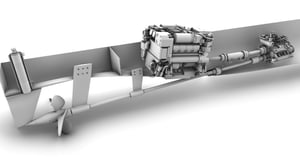Are you unsure of what technology to aim for in a changing maritime market? Looking to get the most out of your investment and vessel when choosing a propulsion manufacturer?
There can be some pitfalls and showstoppers when acquiring a propulsion solution today. Designing and purchasing a vessel is a long and complex process of specification, funding, and expectations.
In short, finding the right solution for your operation is not easy. Therefore, in this article we go through 5 important things to consider when choosing a propulsion manufacturer. Some of these are even easy to overlook, so let’s dive in.
What is a propulsion solution?
When you hear the word propulsion it is easy to think only of propellers. And yes, propellers are literally pivotal in when propelling a vessel, but there is much more to propulsion. A propulsion manufacturer will consider not only the propeller, but also multiple other elements that must be tuned to reach the desired performance.
- The ship’s hull and correct propeller tunnel
- Appendixes, like rudder, brackets, keel, etc.
- Gearbox
- Main drives, like diesel engines, electric motors, etc.
- Control systems
- And more..
All these components fall in under the term “Propulsion solution”. What may surprise you is that propulsion manufacturers rarely supply the power systems or solutions for the energy themselves. Propulsion manufacturers should focus on efficiency, regardless of the power-source. The greatest savings are in the energy you do not use, is a saying in the marine industry. Efficiency should always come first.
So, with that in mind and the stage set, let’s go through a non-exhaustive list of things that are important to consider when choosing your propulsion system and their manufacturer. Bear in mind that each point may inform the other in some way, and they may need to be balanced against each other. It all depends on your operation and the vessels intended use.
5 important things to consider
Vessel’s region of operation and expected tasks
Depth is an important factor of geography and area of operation when it comes to a propulsion system. With some specific operational requirements, vessels may have to be able to get all the way into the shallows or even be able to reliably beach to get to those in need. Some CTVs may operate around wind farms on shallow sandbanks and must handle those conditions.
There will of course be exceptions, but if the waters of operation are very shallow, your main option is a waterjet solution. Here most of the mechanics are embedded into the ship, and with no propeller protruding out from the hull. This reduces your vessel’s draft and may affect who is the ideal manufacturer and supplier.
Read more: Why CPPs are the preferred choice for wind farm vessels
Operational profile
Exactly what your vessel will face in operation can be hard to determine, but what must be determined when finding the optimal solution is operational stability or predictability.
Examples:
- A ferry going inland will have a very predictable operational profile, going between ports with short stops.
- A CTV will have a very different profile, but also predictable. It will go at high intensity between land and installations/rigs, push on the wind mill for crew transfer and later it may loiter for longer periods of time, waiting for crew to return.
These bits of insight determines what the optimal power and propulsion solution is. Should you choose diesel combustion, hybrid or fully electric, and should it be paired with a specific type of propeller or waterjet? Ask a manufacturer. They are after all the experts.
Accepted TCO (Total cost of ownership)
It is not possible to speak of efficiency without talking about your TCO or forecasted OPEX. By large, it revolves around what fuel or energy cost is acceptable, a major part of your OPEX. This again depends on your industry sector, market, and available resources. Some operators may have very low fuel costs, and not focus as much on operational efficiency, while other have clear ambitions and perhaps regulatory/financial guidelines they must follow.
This is also an aspect of the industry and market that is rapidly changing, with an increasing focus on having an efficient operation and vessel.
Read more: The most valuable energy is the one you do not use
Choice of Technology
There is a lot happening in the industry with power technologies. Diesel is still a huge part of the market and can surprisingly be the most efficient and/or green choice, under certain conditions.
For example, if your region or area of operation does not have any electric charging infrastructure, or the energy supplied are coming from fossil fuels, having a hybrid vessel will often mean hauling around many tens of tons of batteries and management systems without the means of charging them at quay. On-board charging has roughly 10% power loss, from feeding electricity to the batteries from your diesel generator, and back out to the electric motors from the battery.
When designing the vessel’s hull lines, it is important with a relationship and communication between the designer and the propeller manufacturer. You must optimize the system with regards for the propeller diameter, propeller tunnel, rudder size, -position and -type. Additionally, the angle of propeller shaft related to the hull base line must be considered.
There is also a time consideration on your delivery. The electric/hybrid market is in high demand, and the major manufacturers have lead times spanning 16 months or more. Demand is high, and manufacturer’s capacity is still growing.
Read more: Efficient Propulsion in a Green Environment, What are the Options?
Manufacturers partners and established service infrastructure
This depends a lot on your region of operation vs. the manufacturer. Having to ship parts and personnel around the world for repairs and service can be a large expense and burden on your operation. Therefore, once you get a clear view of how these points affect each other, it can be recommended to look at the service needs and options for your craft.
Even though your manufacturer of choice does not have a branch in your region, they may have partners and collaborations with other companies that have the capabilities and capacity to take care of your vessel’s need for maintenance through its lifetime.
Conclusion
This is not an exhaustive list of considerations, but some key things we have found can cause friction during your acquisition. These considerations can also affect each other, and some compromises may have to be made. However, the core take away is to holistically look at your vessel, its operation, and your region. It’s a whole comprised of many important parts, just like a propulsion system. And remember; the greatest saving is the energy you do not use.



